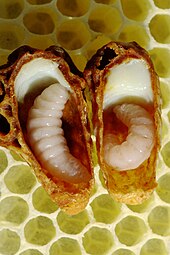Queen cell
Queen cells are the special cells built by honey bees on honeycombs , which are used to raise a queen bee .
description
Because the queen is the largest bee in the hive, the queen cells are significantly larger than the other cells (2 cm) and point vertically downwards. The fertilized egg placed in the queen cell by the queen is fed as a larva by the nurse bees exclusively with food juice ( royal jelly ) produced in their own food glands and thus develops into a queen. Older larvae of the rest of the bee brood, on the other hand, are fed a mixture of nectar and pollen. Because only the different feeding causes a queen to develop instead of a worker, royal jelly is said to have a special, healing and rejuvenating effect.
The production of queen cells is suppressed by the queen using pheromones . If the ratio of pheromone release by the queen to the number of workers is small (e.g. because the queen is old or the number of workers is large), the workers begin to create queen cells. A missing queen also triggers the creation of queen cells. In beekeeping, this is also known as the swarm drive .
With certain breeding methods, the queen cells (cells) are either made by the beekeeper himself from beeswax or bought ready-made from plastic. Then young bee larvae that are one to two days old from colonies that are worth reproducing are reburied in these cells with a umlarv spoon . This process is called umlarvae. Feeding is then done by the workers.
Individual evidence
- ↑ T. Pankiw, ZY. Huang, ML Winston, GE Robinson: Queen mandibular gland pheromone influences worker honey bee (Apis mellifera L.) foraging ontogeny and juvenile hormone titers. In: Journal of Insect Physiology. ( Summary )

